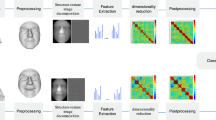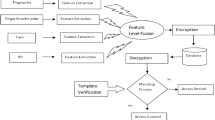Abstract
Presentation attacks that make the biometric systems vulnerable has become a growing concern in recent years keeping in view its widespread applications in the field of banking, medical, security systems etc. For instance, textured contact lenses, high-quality printouts and fabricated synthetic materials spoof the iris texture and fingerprints that lead to increase in false rejection. Till now, extensive work has been done on global features. However, this paper proposed local features with invariance properties. Thus, the paper proposes detection of spoofing attacks in which local features are extracted for micro-textural analysis with properties of invariance to scale, rotation and translation. The features are encoded using Lehmer code and transformed into histograms that act as feature descriptors for classification. The top 4 features are selected using Friedman test. Experiments are simulated on iris spoofing databases: IIITD-Contact Lens, IIITD-Iris Spoofing, Clarkson-2015, Warsaw-2015and fingerprint spoofing databases: LivDet-2013 and LivDet-2015. Results have been validated through intra-sensor, inter-sensor, cross-sensor and cross-material. In case of IIITD-CLI, an EER of 1.36% and an ACER of 1.45% is obtained. For IIS, 0.94% of EER and 1.61% of ACER is observed. For Clarkson database, 0.79% of EER and 2.10% of ACER is obtained. An ACER of 0.57% is obtained for LivDet-2013 and 0.47% for LivDet-2015.










Similar content being viewed by others
Data availability
Data sharing not applicable to this article as no datasets were generated or analyzed during the current study.
References
Antonelli A, Cappelli R, Maio D, Maltoni D (2006) Fake finger detection by skin distortion analysis. IEEE Trans Inf Forensics Secur 1(3):360–373
Arndt J (2011) Matters Computational- Ideas, Algorithms, Source Code. Springer
Baldisserra D, Franco A, Maio D, Maltoni D (2006) Fake fingerprint detection by odor analysis. Springer, pp 265–272
Chugh T, Cao K, Jain AK (2018) Fingerprint spoof buster: use of minutiae-centered patches. IEEE Trans Inf Forensics Secur 13(9):2190–2202
Chugh T, Jain AK (2021) Fingerprint spoof detector generalization. IEEE Trans Inf Forensics Secur 16:42–55
Contreras RC et al (2022) A new multi-filter framework for texture image representation improvement using set of pattern descriptors to fingerprint liveness detection. IEEE Access 10:117681–117706
Daugman J (2004) How iris recognition works. IEEE Trans Circuits Syst Video Technol 14(1):21–30
Ding Y, Ross A (2016) An ensemble of one-class SVMs for fingerprint spoof detection across different fabrication materials. Proc. IEEE International Workshop on Information Forensics and Security, 1–6
Dong Y, Tao D, Li X, Ma J, Pu J (2015) Texture classification and retrieval using shearlets and linear regression. IEEE Trans Cybern 45(3):358–369
Dubey RK, Goh J, Thing VLL (2016) Fingerprint liveness detection from single image using low-level features and shape analysis. IEEE Trans Inf Forensics Secur 11(7):1461–1475
Friedman M (1937) The use of ranks to avoid the assumption of normality implicit in the analysis of variance. J Amer Statist Assoc 32(200):675–701
Galbally J, Alonso-Fernandez F, Fierrez J, Ortega-Garcia J (2009) Fingerprint liveness detection based on quality measures. Int. Conference on Biometrics, Identity and Security (BIDS), 1–8
Ghiani L, Marcialis GL, Roli F (2012) Fingerprint liveness detection by local phase quantization. Proc. 21st Int. Conf. Pattern Recognit. (ICPR), 537–540
Ghiani L, Hadid A, Marcialis G, Roli F (2013) Fingerprint liveness detection using binarized statistical image features. IEEE Int. Conference on Biometrics: Theory Applications and Systems (VISAPP), 1–6
Gragnaniello D, Poggi G, Sansone C, Verdoliva L (2013) Fingerprint liveness detection based on weber local image descriptor. IEEE Workshop on Biometric Measurements and Systems for Security and Medical Applications (BIOMS), 46–50
Gragnaniello D, Poggi G, Sansone C, Verdoliva L (2015) An investigation of local descriptors for biometric spoofing detection. IEEE Trans Inf Forensics Secur 10(4):849–863
Gupta P, Behera S, Vatsa M, Singh R (2014) On iris spoofing using print attack. 22nd international conference on Pattern recognition (ICPR), 1681–1686
González-Soler LJ, Gomez-Barrero M, Chang L, Pérez-Suárez A, Busch C (2019) Fingerprint presentation attack detection based on local features encoding for unknown attacks 1–14. [Online]. http://arxiv.org/abs/1908.101631. Accessed 28 Dec 2023
Gottschlich C, Marasco E, Yang AY, Cukic B (2014) Fingerprint liveness detection based on histograms of invariant gradients. Biometrics (IJCB), 2014 IEEE International Joint Conference on, Clearwater, 1–7
Hu MK (1962) Visual pattern recognition by moment invariants. IRE Trans Informa Theory 8(2):179–187
International Standards Organization (2016) ISO/IEC 30107-1:2016, Information technology-biometric presentation attack detection—Part 1: Framework. https://www.iso.org/standard/53227.html. Accessed 28 Dec 2023
Jenkins J, Roy K, Shelton J (2020) Using deep learning techniques and genetic-based feature extraction forpresentation attack mitigation. Array 7:1–10
Jia X, Yang X, Zang Y, Zhang N, Dai R, Tian J, Zhao J (2013) Multi-scale block local ternary patterns for fingerprint vitality detection. International Conference on Biometrics, 1–6
Jian W, Zhou Y, Liu H (2021) Densely connected convolutional network optimized by genetic algorithm for fingerprint liveness detection. IEEE Access 9:2229–2243
Jiang Y, Liu X (2018) Uniform local binary pattern for fingerprint liveness detection in the gaussian pyramid. J Electr Comput Eng 2018:1–9
Kannala J, Rahtu E (2012) BSIF: Binarized statistical image features. Proc. 21st Int. Conf. Pattern Recognit, 1363–1366
Karasu S, Altan A (2019). Recognition model for solar radiation time series based on random forest with feature selection approach. 11th International Conference on Electrical and Electronics Engineering (ELECO), 8–11
Karasu S, Altan A, Bekiros S, Ahmad W (2020) A new forecasting model with wrapper-based feature selection approach using multi-objective optimization technique for chaotic crude oil time series. Energy 212:1–12
Kaur B (2020) Iris spoofing detection using discrete orthogonal moments. Multimed Tools Appl 79:6623–6647
Kaur B (2023) Iris and Periocular Recognition using Shape Descriptors and Local Invariant Features. 2023 2nd Edition of IEEE Delhi Section Flagship Conference (DELCON), 1–5
Kokkinos I, Yuille A (2008) Scale invariant without scale selection. Proceedings of IEEE Conference on Computer Vision and Pattern Recognition, 1–8
Lapsley PD, Less JA, Pare DF Jr, Hoffman N (1998) Anti-fraud biometric sensor that accurately detects blood flow. SmartTouch, LLC, US Patent #5737439
Lilhore UK, Poongodi M, Kaur A, Simaiya S, Algarni AD, Elmannai H, Vijayakumar V, Tunze GB, Hamdi M (2022) Hybrid model for detection of cervical cancer using causal analysis and machine learning techniques. Comput Math Methods Med 22:1–17
Lowe D (2004) Distinctive image features from scale invariant keypoints. Int J Comput Vis 60(2):91–110
Masek L (2003) Recognition of human iris patterns for biometric identification, 1–7. http://www.csse.uwa.edu.au/opk/studentprojects/labor. Accessed 28 Dec 2023
Mukundan R, Lee PA (2001) Image analysis by tchebichef moments. IEEE Trans Image Process 10(9):1357–1364
Mura V, Ghiani L, Marcialis GL, Roli F, Yambay DA, Schuckers SA (2015) LivDet 2015 - Fingerprint liveness detection competition 2015. Proc. IEEE 7th Intl. Conf. BTAS, 1–6
Nguyen T, Park E, Cui X, Nguyen V, Kim H (2018) FPADnet: Small and efficient convolutional neural network for presentation attack detection. Sensors 18(8):25–32
Nogueira RF, Lotufo RDA, Machado RC (2015) Evaluating software-based fingerprint liveness detection using Convolutional Networks and Local Binary Patterns. In: IEEE Workshop on Biometric Measurements and Systems for Security and Medical Applications Proceedings, pp 22–29
Nogueira RF, de AlencarLotufo R, Machado RC (2016) Fingerprint liveness detection using convolutional neural networks. IEEE Trans Inf ForensicsSecur 11(6):1206–1213
Ojala T, Pietikainen M, Maenpaa T (2001) A generalized local binary pattern operator for multi-resolution gray-scale and rotataion invariant texture classification. Proceedings of International Conference on Advances in Pattern Recognition, 397–406
Ojala T, Pietikainen M, Maenpaa T (2002) Gray scale and rotation invariant texture classification with local binary patterns. IEEE Trans Pattern Anal Mach Intell 24(7):971–987
Pala F, Bhanu B (2017) Deep triplet embedding representations for liveness detection. In: Bhanu B, Kumar A (eds) Deep learning for biometrics. Advances in computer vision and pattern recognition. Springer, Cham
Raghavendra R, Raja KB, Busch C (2014) Ensemble of statistically independent filters for robust contact lens detection in iris images. Proceedings of the 2014 Indian Conference on Computer Vision Graphics and Image Processing, 24
Raghavendra R, Raja KB, Busch C (2017) ContlensNet: Robust iris contact lens detection using deep convolutional neural networks. IEEE Winter Conference on Applications of Computer Vision (WACV), 1160–1167
Rattani A, Scheirer WJ, Ross A (2015) Open set fingerprint spoof detection across novel fabrication materials. IEEE Trans Inf Forensics Secur 10(11):2447–2460
Rehman YAU, Po LM, Liu M (2020) SLNet: Stereo face liveness detection via dynamic disparity-maps and convolutional neural network. Expert Syst Appl 142:1–29
Shukla PK, Sandhu JK, Ahirwar A, Ghai D, Maheshwary P, Shukla PK (2021) Multi-objective genetic algorithm and convolutional neural network based COVID-19 identification in chest X-ray images. Math Probl Eng 2021:1–9
Silva P, Luz E, Baeta R, Pedrini H, Falcao AX, Menotti D (2015) An approach to iris contact lens detection based on deep image representations. 28th SIBGRAPI Conference onGraphics, Patterns and Images (SIBGRAPI),157–164
Spinoulas L, Mirzaalian H, Hussein ME, AbdAlmageed W (2021) Multi-modal fingerprint presentation attack detection: evaluation on a new dataset. IEEE Trans Biom Behav Identity Sci 3(3):347–364
Tapia JE, Gonzalez S, Busch C (2022) Iris liveness detection using a cascade of dedicated deep learning networks. IEEE Trans Inform Forensics Secur 17:42–52
Teague MR (1980) Image analysis via the general theory of moments. J Optic Soc Am 70(8):920–930
Thenuwara SS, Premchandra C, Kawanaka H (2022) A multi-agent based enhancement for multimodal biometric system at border control. Array 14:1–11
Tola E, Lepetit V, Fua P (2010) DAISY: an efficient dense descriptor applied to wide-baseline stereo. IEEE Trans Pattern Anal Mach Intell 32(5):815–830
Uliyan DM, Sadeghi S, Jalab HA (2020) Anti-spoofing method for fingerprint recognition using patch based deep learning machine. Eng Sci Technol Int J 23:264–273
Xia Z, Yuan C, Lv R, Sun X, Xiong NN, Shi YQ (2020) A novel Weber local binary descriptor for fingerprint liveness detection. IEEETrans Syst Man Cybern Syst 50(4):1526–1536
Yadav D, Kohli N, Doyle JS, Singh R, Vatsa M, Bowyer KW (2014) Unraveling the effect of textured contact lenses on iris recognition. IEEE Trans Inf Forensics Secur 9(5):851–862
Yambay D, Walczak B, Schuckers S, Czajka A (2017) LivDet-Iris 2015 - Iris Liveness Detection. IEEE International Conference on Identity, Security and Behavior Analysis, 1–6
Yap PT, Raveendran P, Ong SH (2003) Image analysis by Krawtchouk moments. IEEE Trans Image Process 12(11):1367–1377
Yap PT, Raveendran P, Ong SH (2007) Image analysis using Hahn moments. IEEE Trans Pattern Anal Mach Intell 29(11):2057–2062
Yap PT, Jiang XD, Chung AC (2010) Two-dimensional polar harmonic transforms for invariant image representation. IEEE Trans Pattern Anal Mach Intell 32(7):345–351
Yuan C, Xia Z, Sun X, Sun D, Lv R (2016) Fingerprint liveness detection using multiscale difference co-occurrence matrix. Opt Eng 55(6):063111-1-063111-10
Yuan C, Xia Z, Sun X, Wu QMJ (2020) Deep residual network with adaptive learning framework for fingerprint liveness detection. IEEE Trans Cogn Dev Syst 12(3):461–473
Yuan C, Yu P, Xia Z, Sun X, Wu QMJ (2022a) FLD-SRC: fingerprint liveness detection for AFIS based on spatial ridges continuity. IEEE J Sel Top Signal Process 16(4):817–827
Yuan C, Jiao S, Sun X, Wu QMJ (2022b) MFFFLD: a multimodal-feature-fusion-based fingerprint liveness detection. IEEE Trans Cogn Dev Syst 14(2):648–661
Zhang H, Sun Z, Tan T (2010) Contact lens detection based on weighted LBP. International Conference on Pattern Recognition (ICPR), 4279–4282
Zhang Y, Shi D, Zhan X, Cao D, Zhu K, Li Z (2019) Slim-ResCNN: a deep residual convolutional neural network for fingerprint liveness detection. IEEE Access 7:91476–91487
Zhang Y, Gao C, Pan S, Li Z, Xu Y, Qiu H (2020a) A score-level fusion of fingerprint matching with fingerprint liveness detection. IEEE Access 8:183391–183400
Zhang Y, Pan S, Zhan X, Li Z, Gao M, Gao C (2020b) FLDNet: light dense CNN for fingerprint liveness detection. IEEE Access 8:84141–84152
Author information
Authors and Affiliations
Corresponding author
Ethics declarations
Conflict of interest
The author declares that there is no conflict of interest.
Additional information
Publisher's Note
Springer Nature remains neutral with regard to jurisdictional claims in published maps and institutional affiliations.
Rights and permissions
Springer Nature or its licensor (e.g. a society or other partner) holds exclusive rights to this article under a publishing agreement with the author(s) or other rightsholder(s); author self-archiving of the accepted manuscript version of this article is solely governed by the terms of such publishing agreement and applicable law.
About this article
Cite this article
Kaur, B. Fingerprint and Iris liveness detection using invariant feature-set. Multimed Tools Appl (2024). https://doi.org/10.1007/s11042-023-17854-w
Received:
Revised:
Accepted:
Published:
DOI: https://doi.org/10.1007/s11042-023-17854-w




